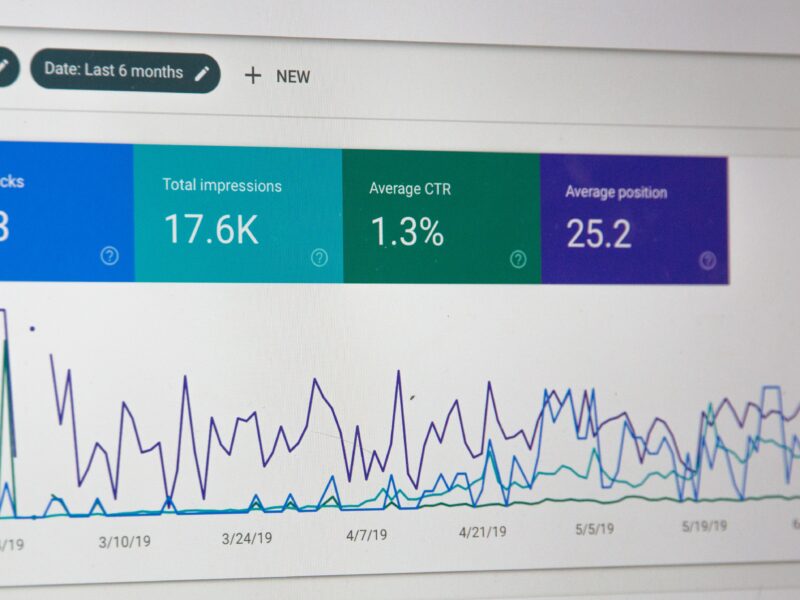Curious about the number of visitors a website receives? Wondering how you can check the traffic on a particular site? Look no further! In this article, we’ll explore various methods and tools that allow you to easily gauge website traffic, providing you with valuable insights and statistics. Whether you’re a business owner, a marketer, or simply a curious internet user, uncovering the secrets behind website traffic has never been easier. Let’s dive right in and learn how you can satisfy your curiosity – and maybe even gain a competitive edge in the process!

Using Website Analytics Tools
When it comes to examining and analyzing the traffic on your website, having the right tools is essential. Website analytics tools provide valuable insights into various metrics that can help you understand your audience, track user behavior, and make data-driven decisions to improve your website’s performance. In this article, we will explore some of the most popular website analytics tools available and discuss how they can be used to gain a better understanding of your website’s traffic.
Google Analytics
Arguably the most well-known and widely used website analytics tool, Google Analytics offers a comprehensive range of features to track and analyze your website’s performance. With Google Analytics, you can monitor various metrics, such as traffic volume, page views, unique visitors, average time on site, bounce rate, conversion rate, referral traffic, organic search traffic, and much more. The tool provides in-depth reports and visualizations, allowing you to gain valuable insights into your audience’s behavior and make informed decisions to optimize your website.
Google Search Console
Another powerful tool from Google, Google Search Console focuses specifically on your website’s visibility in search engine results. With this tool, you can monitor how your website is performing in Google search, identify any issues that may be affecting your rankings, and optimize your site for better visibility. Google Search Console provides valuable data on your website’s search traffic, including the keywords that are driving traffic to your site, the number of impressions and clicks your site receives, and the average position in search results. By understanding how users are finding your site through search engines, you can make targeted improvements to increase organic traffic.
SimilarWeb
SimilarWeb is a website analytics tool that offers a wide range of features to help you understand your website’s traffic and compare it to your competitors. The tool provides data on traffic volume, engagement metrics, traffic sources, and audience demographics. With SimilarWeb, you can gain insights into your competitors’ traffic sources, top referring websites, and even estimate their monthly traffic. This information can be valuable in understanding your industry landscape and identifying opportunities to attract more visitors to your website.
Alexa
Alexa is a popular website analytics tool that offers a suite of features to analyze and benchmark your website’s performance. With Alexa, you can track various metrics, including traffic volume, engagement, and audience insights. The tool provides data on your website’s ranking, top keywords, traffic sources, and audience demographics. Additionally, Alexa offers a competitive analysis feature that allows you to compare your website’s performance to your competitors and identify areas for improvement. By leveraging Alexa’s insights, you can make informed decisions to attract more traffic and improve your website’s overall performance.
Quantcast
Quantcast is a website analytics tool that provides valuable insights into your website’s audience and demographics. With Quantcast, you can understand who your audience is, their interests, and their online behaviors. The tool offers detailed information on traffic volume, engagement metrics, traffic sources, and audience demographics. Quantcast also provides audience segmentation and targeting tools, allowing you to tailor your marketing strategies to specific audience segments. By understanding your audience better, you can create relevant content, optimize your marketing efforts, and attract more targeted traffic to your website.
Compete
Compete is a website analytics tool that offers a range of features to analyze and compare your website’s performance to your competitors. With Compete, you can track your website’s traffic volume, engagement metrics, and audience demographics. The tool also provides insights into your competitors’ traffic sources, top referring websites, and audience demographics. By benchmarking your website against your competitors, you can identify areas for improvement and develop strategies to attract more visitors and stay ahead in the competitive landscape.
SEMrush
SEMrush is a comprehensive digital marketing tool that offers a wide range of features to analyze and optimize your website’s performance. With SEMrush, you can monitor various metrics, including traffic volume, organic search traffic, backlinks, and keyword rankings. The tool provides in-depth reports and competitive analysis features, allowing you to identify opportunities for growth and make data-driven decisions to improve your website’s visibility and attract more traffic.
Ahrefs
Ahrefs is a popular SEO tool that offers a variety of features to analyze and optimize your website’s performance. With Ahrefs, you can track various metrics, including organic search traffic, backlinks, and keyword rankings. The tool provides in-depth reports and competitive analysis features, allowing you to identify your competitors’ top-performing content, analyze their backlink profiles, and uncover opportunities to improve your website’s SEO performance. By leveraging Ahrefs’ insights, you can drive more organic traffic to your website and increase your visibility in search engine results.
Examining Website Metrics
To gain a comprehensive understanding of your website’s traffic, it is essential to examine various metrics that provide insights into your audience’s behavior and engagement. Here are some key website metrics to consider:
Traffic Volume
Traffic volume refers to the total number of visitors your website receives within a specific period. Tracking traffic volume helps you understand the overall popularity and reach of your website. It allows you to see how many people are visiting your site and how it fluctuates over time, helping you identify trends and patterns.
Page Views
Page views indicate the total number of times a page on your website has been viewed. This metric helps you understand which pages on your site are the most popular and engaging for your audience. By analyzing page views, you can identify high-performing content and make data-driven decisions to optimize and improve other pages on your website.
Unique Visitors
Unique visitors represent the number of distinct individuals who have visited your website within a specific period. This metric helps you understand the number of different people your website attracts and provides insights into your website’s reach and audience diversity. By monitoring unique visitors, you can gauge the effectiveness of your marketing efforts and identify opportunities to expand your audience.
Average Time on Site
Average time on site measures the average duration a visitor spends on your website. This metric provides insights into how engaging and valuable your content is. A longer average time on site suggests that visitors find your site interesting and are spending more time consuming your content. By tracking this metric, you can identify pages or sections of your website that need improvement to increase visitor engagement.
Bounce Rate
Bounce rate refers to the percentage of visitors who leave your website after viewing only one page. A high bounce rate can indicate that visitors may not find your content relevant or engaging. By analyzing bounce rate, you can identify pages with a high bounce rate and make necessary improvements to increase visitor retention and encourage further exploration of your site.
Conversion Rate
Conversion rate measures the percentage of visitors who complete a desired action on your website, such as making a purchase, subscribing to a newsletter, or filling out a form. This metric helps you understand the effectiveness of your website in driving conversions. By tracking the conversion rate, you can identify areas for improvement and optimize your website to increase conversion rates.
Referral Traffic
Referral traffic refers to the visitors who come to your website from other websites that have linked to your content. This metric helps you understand which websites are driving traffic to your site and how effective your content promotion efforts are. By analyzing referral traffic, you can identify valuable referring websites and build partnerships or develop strategies to increase referral traffic.
Organic Search Traffic
Organic search traffic represents the visitors who find your website through search engine results without any paid promotion. This metric provides insights into your website’s visibility and ranking in search engine results pages. By tracking organic search traffic, you can identify the keywords that are driving traffic to your site and optimize your content to increase organic visibility.
Direct Traffic
Direct traffic refers to the visitors who come to your website by directly entering the URL or using bookmarks. This metric provides insights into your website’s brand recognition and returning visitor base. By analyzing direct traffic, you can assess the effectiveness of your offline marketing efforts and gauge the loyalty of your audience.
Social Media Traffic
Social media traffic represents the visitors who come to your website through social media platforms. This metric helps you understand the impact of your social media marketing efforts and the effectiveness of your social media content. By tracking social media traffic, you can identify which platforms are driving traffic to your site and optimize your social media strategies to increase engagement.
By examining these website metrics, you can gain a comprehensive understanding of your website’s traffic, audience behavior, and engagement. This information allows you to make data-driven decisions to optimize your website, attract more visitors, and improve overall performance.
Analyzing Traffic Sources
Understanding where your website’s traffic is coming from is essential for optimizing your marketing strategies and identifying opportunities for growth. Here are some key traffic sources to consider:
Referring Websites
Referring websites are external websites that have linked to your content and direct visitors to your website. Analyzing referring websites helps you understand which websites are driving traffic to your site and how effective your content promotion efforts are. By identifying valuable referring websites, you can build partnerships or develop strategies to increase referral traffic.
Search Engines
Search engines, such as Google, Bing, and Yahoo, play a vital role in driving organic traffic to websites. Analyzing search engine traffic helps you understand the keywords that are driving organic search traffic to your site and the effectiveness of your SEO efforts. By identifying popular keywords and optimizing your content, you can increase your visibility in search engine results pages and attract more organic traffic.
Social Media Platforms
Social media platforms, such as Facebook, Twitter, Instagram, and LinkedIn, have become significant sources of website traffic. Analyzing social media traffic helps you understand the impact of your social media marketing efforts and the effectiveness of your social media content. By identifying the platforms that are driving traffic to your site, you can optimize your social media strategies to increase engagement and attract more visitors.
Direct Visitors
Direct visitors are those who come to your website by directly entering the URL or using bookmarks. Analyzing direct traffic helps you understand the effectiveness of your offline marketing efforts and the loyalty of your audience. By identifying trends in direct traffic, you can assess the impact of your branding and offline marketing campaigns and develop strategies to increase direct traffic.
Paid Advertising
Paid advertising, such as Google Ads, social media ads, and display ads, can be a significant source of website traffic. Analyzing paid advertising traffic helps you understand the effectiveness of your ad campaigns and the ROI of your advertising budget. By tracking paid traffic, you can optimize your advertising strategies, identify high-performing campaigns, and allocate your budget to channels that drive the most valuable traffic.
Email Marketing
Email marketing campaigns can be an effective way to drive targeted traffic to your website. Analyzing email marketing traffic helps you understand the effectiveness of your email campaigns, including open rates, click-through rates, and conversions. By tracking email traffic, you can identify the types of content and offers that resonate with your email subscribers and optimize your email marketing strategies for better engagement and traffic generation.
Affiliate Marketing
Affiliate marketing involves partnering with other websites or individuals who promote your products or services in exchange for a commission. Analyzing affiliate marketing traffic helps you understand the effectiveness of your affiliate partnerships and the traffic generated through affiliate links. By tracking affiliate traffic, you can identify high-performing affiliates, optimize your partnerships, and increase your website’s visibility and conversion rates.
Online Communities and Forums
Active participation in online communities and forums relevant to your industry can drive targeted traffic to your website. Analyzing traffic from online communities helps you understand the impact of your community engagement efforts and the engagement level of community members with your content. By tracking this traffic, you can identify valuable online communities, build relationships, and generate more targeted traffic to your website.
By analyzing these traffic sources, you can identify the most effective channels for driving traffic to your website and optimize your marketing strategies accordingly. Understanding the sources of your website’s traffic allows you to allocate resources effectively, identify opportunities for growth, and attract more targeted visitors to your site.
Monitoring User Behavior
Understanding how users interact with your website is crucial for optimizing user experience and driving conversions. Here are some key aspects of user behavior to monitor:
Website Heatmaps
Website heatmaps provide visual representations of how users interact with your website’s pages. Heatmaps highlight areas of the page that attract the most attention, including where users click, scroll, and spend the most time. By analyzing website heatmaps, you can identify patterns of user behavior, optimize the placement of important elements, and improve overall user experience.
Click Tracking
Click tracking allows you to monitor and analyze where users click on your website. By tracking clicks, you can identify which links, buttons, and elements attract the most attention and drive user engagement. Click tracking data helps you optimize your website’s design and navigation, improve call-to-action placement, and increase conversions.
Scroll Tracking
Scroll tracking measures how far users scroll down a webpage before leaving or engaging with specific elements. By tracking scroll depth, you can identify the areas of your page that receive the most attention and optimize the placement of important content and calls-to-action. Understanding scroll behavior helps you improve user engagement and ensure that important information is visible to users.
Conversion Funnels
Conversion funnels track the steps users take on your website leading up to a specific conversion goal, such as making a purchase or filling out a form. By analyzing conversion funnels, you can identify areas of drop-off or friction in the conversion process and optimize your website to increase conversion rates. Understanding user behavior within conversion funnels helps you pinpoint the factors that influence conversions and make data-driven decisions to improve the user experience.
Exit Pages
Exit pages are the last pages users visit before leaving your website. Analyzing exit pages helps you understand which pages have the highest exit rates and identify potential issues that may be causing users to leave. By optimizing exit pages, you can encourage users to explore more of your website, reduce bounce rates, and increase engagement.
Site Search Analysis
If your website has a search function, analyzing site search data provides valuable insights into what users are looking for on your site. By tracking site search queries and analyzing search behavior, you can identify popular search terms, uncover gaps in your content, and optimize your website’s search functionality to improve user experience and drive engagement.
Event Tracking
Event tracking allows you to monitor and analyze specific user actions on your website, such as clicks, form submissions, video plays, and downloads. By setting up event tracking, you can gain insights into user engagement and conversions related to specific events. Event tracking data helps you optimize your website’s performance, improve user experience, and increase overall engagement.
Form Analytics
If your website includes forms, such as contact forms or registration forms, analyzing form analytics can provide insights into user behavior and form completion rates. By tracking form analytics, you can identify fields that cause friction or confusion, optimize the user experience, and increase form submission rates. Understanding user behavior within forms helps you reduce abandonment and improve overall conversion rates.
By monitoring and analyzing user behavior on your website, you can gain insights into how users interact with your content, identify areas of improvement, and make data-driven decisions to optimize the user experience and drive conversions.

Web Server Logs
Web server logs contain valuable information about your website’s visitors, server requests, and errors. Analyzing web server logs can provide valuable insights into the technical aspects of your website’s performance. Here are some key elements of web server logs to consider:
Access Logs
Access logs record every HTTP request made to your web server, including information about the visitor’s IP address, the requested URL, the user agent, and the HTTP response code. By analyzing access logs, you can understand who is accessing your website, which pages are being requested, and how the server is responding to those requests. Access logs are valuable for troubleshooting performance issues, identifying potential security threats, and understanding overall server health.
Error Logs
Error logs record any errors or warnings that occur on your website, such as 404 errors (page not found) or server-side errors. Analyzing error logs helps you identify and resolve issues that may be affecting user experience and search engine rankings. By monitoring error logs, you can ensure that your website is functioning properly, improve the user experience, and fix any technical issues promptly.
Referrer Logs
Referrer logs record the websites or sources that refer visitors to your website. Analyzing referrer logs helps you understand which websites are driving traffic to your site and how effective your marketing and promotion efforts are. By tracking referrer logs, you can identify valuable referring websites, optimize your marketing strategies, and attract more targeted traffic to your website.
User Agent Logs
User agent logs contain information about the web browser, operating system, and device used by the visitor accessing your website. Analyzing user agent logs helps you understand the devices and browsers used by your audience and optimize your website’s design and functionality accordingly. By tracking user agent logs, you can ensure that your website is compatible with popular devices and browsers, provide a seamless user experience, and improve overall user satisfaction.
IP Logs
IP logs record the IP addresses of visitors accessing your website. Analyzing IP logs can help you identify potential security threats, track suspicious behavior, and differentiate between legitimate and malicious traffic. By monitoring IP logs, you can enhance your website’s security, protect user data, and mitigate the risk of cyberattacks.
Filtering and Analyzing Logs
To effectively analyze web server logs, it is important to filter and extract relevant data. This can be done using log analysis tools or by creating custom scripts or queries. By filtering and analyzing logs, you can extract valuable insights, identify trends and patterns, and make informed decisions to improve your website’s performance, security, and user experience.
Using Traffic Estimation Tools
While website analytics tools provide valuable insights into your website’s actual traffic, traffic estimation tools can offer additional data and comparative analysis. Here are some notable tools to estimate website traffic:
Estimating Traffic with Alexa
Alexa offers a traffic estimation feature that provides an estimate of a website’s monthly traffic based on a combination of data sources, including site visits, page views, and unique visitors. Alexa’s traffic estimation helps you understand the popularity and reach of your website compared to other sites. By comparing your estimated traffic to your competitors’ traffic, you can identify areas for improvement, set realistic goals, and develop marketing strategies to attract more visitors.
SimilarWeb Traffic Estimator
SimilarWeb offers a traffic estimator tool that provides an estimate of a website’s monthly traffic based on a variety of data sources, including browsing behavior, internet service provider data, and panel-based methodologies. SimilarWeb’s traffic estimator helps you understand the market share and potential audience reach of your website. By utilizing SimilarWeb’s data, you can optimize your marketing efforts, identify opportunities for growth, and benchmark your website’s performance against your competitors.
SEMrush Traffic Analytics
SEMrush offers a traffic analytics feature that provides valuable insights into a website’s traffic based on various data sources, including clickstream data, behavioral data, and panel-based methodologies. SEMrush’s traffic analytics helps you understand the organic and paid search traffic to your website and provides an estimate of your competitors’ traffic. By leveraging SEMrush’s data, you can uncover keywords that drive traffic, identify content gaps, and make data-driven decisions to increase your website’s visibility and attract more targeted visitors.
Ahrefs Site Explorer
Ahrefs’ Site Explorer provides comprehensive analysis of a website’s performance, including traffic estimation based on a variety of data sources, such as clickstream data, search data, and panel-based methodologies. Ahrefs’ traffic estimation helps you understand the organic search traffic to your website, analyze your competitors’ traffic, and identify opportunities for growth. By utilizing Ahrefs’ data, you can optimize your content, build quality backlinks, and improve your website’s visibility in search engine results.
By utilizing traffic estimation tools, you can gain additional insights into your website’s traffic, compare your performance to competitors, and make data-driven decisions to attract more visitors and increase your website’s visibility.

Comparing Competitor Traffic
Analyzing competitor traffic can provide valuable insights into your industry landscape and help you benchmark your website’s performance. Here are some tools that offer competitive analysis features:
Alexa’s Competitor Analysis
Alexa’s competitor analysis feature allows you to compare your website’s traffic, engagement metrics, and audience demographics to your competitors. By analyzing competitor data, you can identify areas for improvement, track industry trends, and develop strategies to attract more traffic. Alexa’s competitive analysis feature provides a comprehensive view of your competitors’ performance and helps you stay ahead in the competitive landscape.
SimilarWeb’s Competitive Analysis
SimilarWeb’s competitive analysis feature offers detailed insights into your competitors’ website traffic, engagement metrics, traffic sources, and audience demographics. By analyzing competitive data, you can understand which websites are driving traffic to your competitors, identify valuable referring websites, and optimize your marketing strategies accordingly. SimilarWeb’s competitive analysis allows you to benchmark your website’s performance, uncover industry trends, and make informed decisions to attract more visitors.
SEMrush Domain Overview
SEMrush’s domain overview feature provides a comprehensive analysis of a website’s performance, including traffic estimation, organic and paid search traffic, backlinks, and keyword rankings. By using SEMrush’s domain overview, you can analyze your competitors’ traffic sources, identify high-performing keywords, and uncover content gaps. This information helps you optimize your marketing efforts, improve your website’s visibility, and attract more targeted traffic.
Ahrefs Site Explorer
Ahrefs’ Site Explorer offers a range of competitive analysis features, including traffic estimation, organic and paid search traffic, backlinks, and keyword rankings. By utilizing Ahrefs’ Site Explorer, you can compare your website’s performance to your competitors’, identify their top-performing content, and analyze their backlink profiles. This information helps you optimize your content, build quality backlinks, and improve your website’s visibility and performance in search engine results.
By comparing your website’s performance to your competitors’, you can identify areas for improvement, track industry trends, and make data-driven decisions to attract more visitors and stay ahead in the competitive landscape.
Meta Tag Analysis
Meta tags play a crucial role in search engine optimization (SEO) and improving the visibility of your website in search engine results. Here are some key elements of meta tag analysis:
Title Tags
Title tags are HTML elements that define the title of a web page. Analyzing title tags helps you understand how effectively your titles represent the content of your pages and target relevant keywords. By optimizing your title tags, you can improve your website’s visibility in search engine results and increase click-through rates.
Meta Descriptions
Meta descriptions are HTML elements that provide concise summaries of web page content. Analyzing meta descriptions helps you ensure that they accurately represent the content of your pages and entice users to click through to your website. By optimizing meta descriptions, you can improve your website’s click-through rates, user engagement, and search engine visibility.
Keywords
Keywords are words or phrases that indicate the content and relevance of a web page. Analyzing keywords helps you ensure that you are using relevant keywords in your website’s meta tags and content. By optimizing keywords, you can increase your website’s visibility in search engine results and attract more targeted organic traffic.
Open Graph Protocol
The Open Graph Protocol is a set of meta tags that allows social media platforms to understand your website’s content when it is shared. Analyzing the Open Graph Protocol helps you ensure that your website’s content is effectively represented on social media platforms, increasing its visibility and engagement. By optimizing the Open Graph Protocol, you can enhance the appearance of your website’s shared content and attract more traffic from social media platforms.
Twitter Card Metadata
Twitter Card metadata are meta tags specifically designed for Twitter that allow you to control how your website’s content appears when shared on the platform. Analyzing Twitter Card metadata helps you ensure that your website’s content is effectively represented on Twitter, increasing its visibility and engagement. By optimizing Twitter Card metadata, you can enhance the appearance of your website’s shared content on Twitter and attract more traffic from the platform.
Schema Markup
Schema markup is a structured data vocabulary that allows search engines to understand the content and context of your web pages. Analyzing schema markup helps you ensure that your website’s content is properly structured and understood by search engines. By implementing schema markup, you can improve your website’s visibility in search engine results and enhance the user experience.
By analyzing and optimizing meta tags, you can improve your website’s visibility in search engine results, attract more organic traffic, and enhance the user experience across different platforms and devices.

Tracking Advertising Campaigns
Tracking the performance of your advertising campaigns is essential to understand their effectiveness and optimize your marketing strategies. Here are some key elements of tracking advertising campaigns:
UTM Parameters
UTM parameters are tags added to your website’s URLs that help track the performance of your marketing campaigns in Google Analytics. By using UTM parameters, you can identify the sources, mediums, and campaigns that are driving traffic to your website. This data helps you understand the effectiveness of your advertising efforts, optimize your campaigns, and allocate your marketing budget more effectively.
URL Shorteners
URL shorteners, such as Bitly and Rebrandly, allow you to create shorter, more concise URLs for your marketing campaigns. By using URL shorteners, you can track the number of clicks on your shortened links, as well as gather data on the geographic location and device of the users who clicked on the links. This information helps you analyze the performance of your marketing campaigns and make data-driven decisions to optimize your strategies.
Tag Management Systems
Tag management systems, such as Google Tag Manager, streamline the process of managing and deploying tracking tags on your website. By using a tag management system, you can easily add and update tracking tags, such as Google Analytics or conversion tracking tags, without needing to modify your website’s code. This simplifies the process of tracking advertising campaigns and allows you to efficiently manage your marketing and analytics tags.
Conversion Tracking
Conversion tracking allows you to track and measure specific actions users take on your website, such as making a purchase or signing up for a newsletter. By setting up conversion tracking, you can understand the effectiveness of your advertising campaigns, identify high-performing channels, and allocate your marketing budget accordingly. Conversion tracking data helps you optimize your advertising efforts, increase conversions, and maximize your return on investment.
Goal Tracking
Goal tracking in Google Analytics allows you to track predefined website goals, such as form submissions, downloads, or newsletter sign-ups. By setting up goal tracking, you can monitor the conversion rates of your marketing campaigns and optimize your strategies to achieve higher goal completion rates. Goal tracking data helps you understand the impact of your marketing efforts, make data-driven decisions, and drive more conversions.
By effectively tracking your advertising campaigns, you can gain insights into their performance, identify areas for improvement, and optimize your marketing strategies to attract more targeted traffic and drive conversions.
Data Privacy and Legal Considerations
When dealing with website analytics and tracking user data, it is essential to consider data privacy and legal requirements. Here are some key considerations:
GDPR Compliance
The General Data Protection Regulation (GDPR) is a data protection and privacy regulation that applies to businesses operating within the European Union (EU) or targeting EU residents. GDPR compliance includes obtaining appropriate consent from website visitors before collecting and tracking their personal data, implementing measures to protect user data, and providing transparency and control over data usage. By ensuring GDPR compliance, you can build trust with your website visitors, avoid costly legal consequences, and protect user privacy.
Cookie Consent
Many website analytics tools use cookies to track user behavior. In many jurisdictions, including the EU, obtaining consent from users before placing cookies on their devices is a legal requirement. By implementing a cookie consent mechanism, such as a banner or pop-up, you can ensure that you are transparent about the use of cookies on your website and comply with relevant data protection regulations.
Anonymization of IP Addresses
IP addresses are considered personal data in many jurisdictions. Anonymizing IP addresses (removing the last octet) before storing or processing them ensures compliance with data protection regulations and protects user privacy. By anonymizing IP addresses, you can track website traffic while respecting user privacy and complying with legal requirements.
Data Protection Agreements
If you share personal data with third-party analytics providers or store data on cloud-based platforms, it is essential to have data protection agreements or data processing agreements (DPAs) in place. These agreements outline the responsibilities and obligations of both parties regarding the protection and processing of personal data. By having DPAs in place, you can ensure that your data is handled securely and in compliance with data protection regulations.
Data Retention Policies
Data retention policies define how long you store user data and ensure compliance with legal requirements. By implementing data retention policies, you can ensure that you retain user data only for as long as necessary, reducing the risk of data breaches and potential legal consequences. It is important to review and update your data retention policies regularly to align with changing legal requirements.
By considering data privacy and legal requirements, you can ensure that your website analytics practices are compliant, protect user privacy, and build trust with your website visitors.
In conclusion, website analytics tools provide valuable insights into your website’s traffic, user behavior, and performance. By utilizing these tools, you can gain a comprehensive understanding of your audience, track the effectiveness of your marketing efforts, and make data-driven decisions to optimize your website. From tracking traffic volume and analyzing user behavior to monitoring advertising campaigns and ensuring data privacy compliance, website analytics tools are essential for the success of your online presence. With a combination of powerful analytics tools and a focus on understanding your audience, you can drive more targeted traffic, increase engagement, and achieve your website goals.



